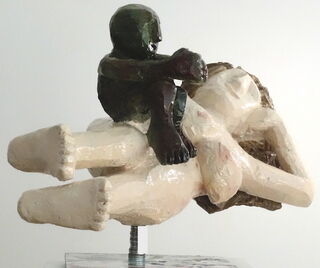Sculpture "manand woman" (2020) (Unique piece), aluminium
Sculpture "manand woman" (2020) (Unique piece), aluminium
Quick info
unique piece | aluminium | hand-painted | size 29 x 60 x 25 cm (h x w x d)
Detailed description
Sculpture "manand woman" (2020) (Unique piece), aluminium
Sculpture made of aluminium, painted, 2020. Height: 29 cm. Width: 60 cm, depth: 25 cm.
About Daniel Wagenblast
The sculptor Daniel Wagenblast, born in Schwäbisch Gmünd, Germany, in 1963, studied at the State Academy of Fine Arts in Stuttgart under Professors Peter Grau and Rudolf Schoofs. Wagenblast has lived and worked in Stuttgart since 1990.
Wagenblast consistently works with figuration, which he doesn't smooth or embellish he rather reveals its materiality with rugged surfaces. The bronze or wooden figures always seem to be removed from the viewers and move in their own cosmos. One of the main protagonists in the artist's repertoire is the world traveller, whom he usually depicts with a gesture of looking out, thus awakening in the recipient associations of a quest, an exploration of the unknown and wanderlust.
Wagenblast has received numerous scholarships, including from the Kunststiftung des Landes Baden-Württemberg.
A plastic work of sculptural art made of wood, stone, ivory, bronze or other metals.
While sculptures from wood, ivory or stone are made directly from the block of material, in bronze casting a working model is prepared at first. Usually, it is made of clay or other easily mouldable materials.
The prime time of sculpture after the Greek and Roman antiquity was the Renaissance. Impressionism gave a new impulse to the sculptural arts. Contemporary artists such as Jorg Immendorf, Andora, and Markus Lupertz also enriched sculptures with outstanding works.
A one-of-a-kind or unique piece is a work of art that has been personally created by the artist. It exists only once due to the type of production (oil painting, watercolours, drawing, etc.).
In addition to the classic unique pieces, there exist the so-called "serial unique pieces". They present a series of works with the same colour, motif and technique, manually prepared by the same artist. The serial unique pieces are rooted in "serial art", a type of modern art, that aims to create an aesthetic effect through series, repetitions and variations of the same objects or themes or a system of constant and variable elements or principles.
In the history of arts, the starting point of this trend was the work "Les Meules" (1890/1891) by Claude Monet, in which for the first time a series was created that went beyond a mere group of works. The other artists, who addressed to the serial art, include Claude Monet, Piet Mondrian and above all Gerhard Richter.









